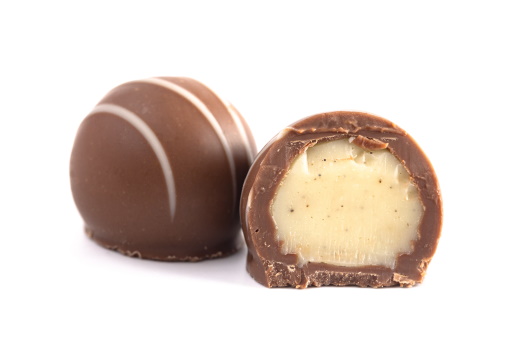Use of skimmed milk powder to prevent fat migration

Chocolate and particularly filled chocolates are loved by consumers and are not prone to microbial or chemical spoiling. Their shelf-life is, however, often limited by physical changes: With increasing storage time the probability of bloom forming increases. Bloom is a white layer on the product surface that consumers often associate with mold formation and so is not accepted by them.
Bloom is exacerbated by migration of fat from chocolate fillings, with two mechanisms being debated for this: A: Diffusion solely within the fat phases; B: Diffusion along the particle surfaces or via intraparticle hollows (capillary forces). The focus of past research work was placed on mechanism A. Studies by the Fraunhofer IVV on industrially produced praline cases also showed, however, that the replacement of 6% sugar with sprayed skimmed milk powder retards bloom formation in chocolates. This finding was the driving force for the current project work that is concentrating on mechanism B and investigating the extent to which bloom formation can be minimized by customized use of milk components in the chocolate mass.
Manufacturing process and milk powder properties influence bloom formation
Depending on how it is manufactured, milk powder has different particle shape, structure, surface properties, and lactose state. Research has not hitherto been undertaken to determine the bloom-retarding potential of dried skimmed milk and what powder is the most effective at minimizing the migration of fat from fillings into the chocolate cases. During manufacture the various technologies used by industry, namely grinding by a roller or ball mill, and the altered rheological properties of the chocolate mass naturally largely determine the subsequent properties of the powder.
Chocolate experts at the Fraunhofer IVV and TU Dresden working together
In order to investigate all the factors and interrelationships in as much detail as possible the Fraunhofer IVV is carrying out the project work with TU Dresden: The Fraunhofer IVV is responsible for characterizing the milk components and manufacturing chocolate masses and product samples as well as investigating the interactions of particle surfaces, cacao butter, and fat from the filling. TU Dresden on the other hand is involved in the comprehensive characterization of the particle morphology and the rheological measurements. Detailed analysis as a function of time and temperature will allow evaluation of the suppression of the migration of fats from fillings into praline cases induced by the milk powder and its components.
Project term: |
2019 to 2021 |
Project management |
Federation of Industrial Research Associations (AiF) (via the Forschungskreis der Ernährungsindustrie e.V. (FEI)) |
 Fraunhofer Institute for Process Engineering and Packaging IVV
Fraunhofer Institute for Process Engineering and Packaging IVV